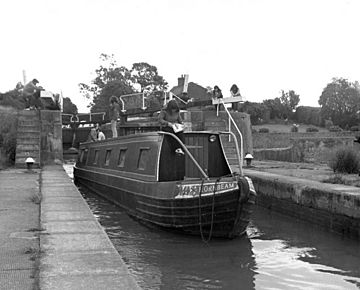Bascote Locks facts for kids

A narrow boat in 1979 entering lock 15, the bottom half of the staircase pair.
|
|
| Waterway | Grand Union Canal |
|---|---|
| County | Warwickshire |
| Maintained by | British Waterways |
| Operation | Mechanical |
| First built | 1800 |
| Latest built | 1930s |
| Length | 83 feet 6 inches (25.5 m) |
| Width | 15 feet (4.6 m) |
| Fall | 26 feet 6 inches (8.08 m) |
Bascote Locks are a series of four locks on the Grand Union Canal in Warwickshire, England. Locks are like water elevators that help boats move up or down hills on a canal. These locks are part of the British canal system, which connects major cities like London and Birmingham. One special part of Bascote Locks is a "staircase" lock, where two locks are built right next to each other. You can also see parts of older, narrower locks here.
Contents
The Story of Bascote Locks
Building the Canal: A New Route
The Bascote Locks are on a part of the canal that was first meant to be called the Warwick and Braunston Canal. In 1794, a special law called an Act of Parliament allowed it to be built. The plan was for a canal about 17.8 miles (28.6 km) long. It would connect from Warwick to the Grand Junction Canal at Braunston.
Work on the canal started in 1795. But soon, someone suggested a different plan. A man named Charles Handley thought they could save a lot of money, about £50,000, if the canal ended at Napton instead of Braunston. Napton was on the Oxford Canal. So, in 1796, a second law was passed. This new law approved a different route. The company then became the Warwick and Napton Canal company. Bascote Locks were built on this new route. They would not have been there if the first plan had been followed.
Opening the Canal and Early Challenges
The Grand Junction Canal was building its route from London to Braunston. They wanted their canal to be wide enough for big boats. They tried to convince the Warwick and Napton Canal to do the same. But the Warwick and Napton company believed most boats would come from the Birmingham canal system. These boats were usually narrow. So, they built their locks for 7 feet (2.1 m) wide boats.
The canal opened on March 19, 1800. The Grand Junction Canal also opened to Braunston later that year. The four Bascote locks are numbers 14 to 17. They are part of 23 locks that go down from Napton. The last one is called Radford Bottom Lock. It is near where the canal changed from its first planned route. Two more locks helped boats go up again before joining the Warwick and Birmingham Canal.
Facing Competition and Upgrading the Canal
In the 1850s, both the Warwick and Napton Canal and the Birmingham and Warwick Canal faced big challenges. New railways were built, which were much faster for moving goods. The canal companies had serious money problems. They were reorganized and kept operating.
From 1917, these two canals were managed together. Then, on January 1, 1929, they were sold to the Regent's Canal. Along with the Grand Junction Canal, they became part of the new Grand Union Canal. The new company wanted to make the canals better. Their goal was to allow wide barges to travel between London and Birmingham. They wanted to fit barges 12.5 feet (3.8 m) wide right away. Eventually, they hoped to fit even wider 14 feet (4.3 m) barges.
As part of this big upgrade, 52 locks on the two Warwick canals were changed. They became weirs, which are like small dams. Also, 51 new, wider locks were built. Each new lock was about 83.5 by 15 feet (25.5 by 4.6 m). One less lock was needed because a group of six locks at Knowle was replaced by five. To make the canal deeper, they raised the height of weirs or lowered the bottom of the locks.
At Bascote, the top two locks were made into a "staircase" pair. This means they are built right next to each other. The Duke of Kent officially opened the project on October 30, 1934, at the top lock of the Hatton flight. But work continued until 1937. Even though the new locks were wide, the bottom of the canal was not widened everywhere. This meant that two very wide boats could not always pass each other. So, the new locks were mostly used by pairs of narrow boats.
Where Are Bascote Locks?
Like many locks on this part of the canal, you can still see parts of the original, older locks next to the newer ones. The four Bascote locks raise the canal's water level by about 26.75 feet (8.15 m). Below the bottom lock, the canal is flat for about 0.4 miles (0.64 km) until Welsh Road Lock. Above the top lock, the canal is flat for about 1.6 miles (2.6 km) to Itchington Bottom Lock. The "paddles" (which are like large valves that control water flow) on these locks look like those from the original Warwick and Napton Canal. They are different from the paddles further south, which were built by the Grand Junction company.

